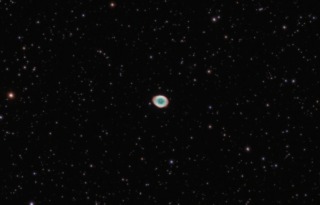
- Constellation: Taurus
- Right Ascension: 04h 09m 16.98573s
- Declination: +30° 46′ 33.4699″
- Distance: 1520 ly
NGC 1514 aka Crystal Ball Nebula is a planetary nebula located in the constellation of Taurus. It was formed from a binary star system when one of the stars ejected gas and dust from its outer shell, in its late red giant phase.
- Details
- Category: Nebulas
- Telescope: Explore Scientific 127 Refractor
- Camera: ZWO 2600 MM

- Constellation: Sagittarius
- Right Ascension: 18h 03m 37s
- Declination: −24° 23′ 12″
- Distance: 4,100 ly
Messier 8 is a large emission nebula located in Sagittarius. Intense ultraviolet radiation emitted from hot young stars in the nebula cause the atomic hydrogen to glow a pinkish red. A star forming region, the nebula contains the open cluster NGC 6530 along with several Bok globules, which are dark collapsing areas of the nebula, along with 4 Herbig-Haro objects which are patches of nebulosity associated with newly born stars. The entire nebula spans a radius of 55 ly x 20 ly. It is one of only two nebula in the northern hemisphere barely visible as a patch of nebulosity. The other being the Orion Nebula.
- Details
- Category: Nebulas
Read more: Messier 8 - Lagoon Nebula (2022)
- Telescope: Explore Scientific 127 Refractor
- Camera: ZWO 2600 MM

- Constellation: Monoceros
- Right Ascension: 6h 39m 10s
- Declination: +8° 45′
- Distance: 2,500 ly
So named because of its changing light and dark patterns on the nebula is though to be caused by dust clouds near the illuminating source by the star R Monocerotis casting shadows on the nebula. The star itself a T Tauri variable, is encased dense clouds of dust.
The patterns are know to change over weeks and months. Discovered by William Herschel and studied by Edin Hubble.
- Details
- Category: Nebulas
- Telescope: Explore Scientific 127 Refractor
- Camera: ZWO 1600 MM

- Constellation: Perseus
- Right Ascension: 04h 03m 15.9s
- Declination: +51° 18′ 54″
- Distance: 11,700 ly
Emission nebula NGC 1491, sometimes called the Fossil Footprint Nebula located in Perseus. Located about 10,700 light years away. Illuminated by a 11.2 magnitude star actually blowing a bubble in the nebula from its intense stellar "wind".
- Details
- Category: Nebulas
- Telescope: Explore Scientific 127 Refractor
- Camera: ZWO 1600 MM

- Constellation: Orion
- Right Ascension: 05h 35m 17.3s
- Declination: −05° 23′ 28″
- Distance: 1,300 ly
Messier 42, The Orion Nebula is one of the most iconic deep sky objects and one of the brightest nebula, it can be seen as a fuzzy star in the sword of Orion figure. Illuminated by a central cluster of stars, the four primary ones are referred to as the Trapezium, for their shape of a trapezoid. As a stellar nursery it is in the process of forming new stars as pockets of the nebula collapse under gravity.
- Details
- Category: Nebulas
- Telescope: EDT 80mm Reftactor
- Camera: ZWO A071 Color

- Constellation: Lyra
- Right Ascension: 18h 53m 35.079s
- Declination: +33° 01′ 45.03″
- Distance: 2,567 ly
Messier 57 is a planetary nebula located in Lyra. A planetary nebula when a star nears the end of its life at the end of its red giant phase, the outer layers are blown off as the star shrinks down to be come a white dwarf. The exposed core of the star ionizes the surrounding gas causing it to glow. Planetary nebula typically only last a few ten thousands of years as the gas dissipates.
The blueish-green light comes from ionized oxygen, and the red outer layers come from ionized hydrogen. In deeper images it can be seen extending out much further. The central star shines at magnitude 14.8
- Details
- Category: Nebulas
- Telescope: Explore Scientific 127 Refractor
- Camera: ZWO 1600 MM